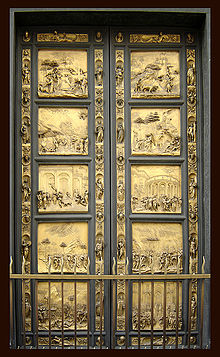Art and the Deluge in Florence
by Ino Manalo
In the early morning light, when everything is awash in the beginning of a new day, the Arno looks so peaceful. Yet, just as Filipinos were unprepared for what Typhoon Ondoy unleashed, the residents of Florence could not imagine the devastation that their beloved river would cause. In November of 1966, after incessant rains, the Arno broke its banks and submerged the great city of the Renaissance. Much would be lost in terms of life and livelihood.
The flood is said to have reached levels above 20 feet as indicated by commemorative markers on the walls of buildings. One source narrates how women went crazy with fear, throwing things from windows while imploring for help to save their children. More than a hundred people would die. Whole communities were left isolated for days and vast tracts of farmland were ruined. It is estimated that 6000 shops had to close. From the stores lining the Ponte Vecchio, the flood bore off gold jewelry never to be seen again. Wanda Ferragamo reported that the shoes from their storage rooms were swept kilometers away.



The losses included cultural treasures. Millions of books were damaged along with about 14, 000 works of art. To this day, the crucifix by Giovanni Cimabue, though rescued from the rampaging waters and restored, still bears the marks of the flood. It hangs in the Church of Santa Croce as a testament to the power of the Arno
Even after the waters had receded, Florence’s ordeal was not yet over. The whole city was buried under a thick coat of muck and garbage. Fuel tanks had broken and oil had combined with the sediment to form a horribly corrosive mixture. Important masterpieces were disintegrating in this vile brew. How, many asked, would there be enough people to clean up the mess and restore order?
Fortunately, the world’s response to the call to save the Cradle of the Renaissance was overwhelming. The late Ted Kennedy remembers how, while visiting Rome on the day of the flood, he received a phone call from his famous sister-in-law, Jacqueline. She asked that he go on to Florence to help. Addressing the audience gathered for the anniversary ceremonies to commemorate the inundation forty years later, Senator Kennedy movingly recounted how, in the darkness of a ruined library, he saw that a human chain had been formed. Along this chain were carried, from one careful hand to another, fragile manuscripts to be liberated from the quagmire.
The Great Flood or L’Alluvione as it would come to be known would generate a deluge of concern. Miraculously, countless volunteers came from all over the planet to help the Florentines save lives and property. These heroes, many of whom were young people, would later be called the angeli del fango – the mud angels. Philippine art gallery owner, Silvana Diaz, who was studying in London at the time, remembers forming collection brigades for donations from Britain. In the end, the Italian students came up with a brilliant idea: they would generate assistance for Florence by rewarding donors with a most tantalizing prize - pots of home-cooked food!
The global outpouring of assistance clearly showed that the art of Florence did not just belong to the Florentines. It was the inheritance and responsibility of all humanity. Even before the city and its treasures were inscribed on UNESCO’s World Heritage List in 1982, the rescue efforts of 1966 had already demonstrated that, without a doubt, the whole world cherished Florence as its very own.
On the fortieth anniversary of L’Alluvione, about 2000 mud angels were invited back for a reunion. The whole city celebrated. Important buildings were decked out in bright purple lights, images were projected on walls, exhibitions were held.
Dark Water, a fascinating book by Robert Clark about the events of the flood came out in 2008. The cover carries David Lees’s haunting photograph from Life Magazine. It shows the matchless statue of David standing so alone, so vulnerable in a gallery covered with a layer of mud.
Looking at the picture, one is reminded of a poignant scene from the 2006 movie, Children of Men. The lead character, Theo, needing a critical favor, visits Nigel who is a very influential person in the film’s post-apocalyptic society. As Theo enters Nigel’s quarters, one sees in the background Michelangelo’s David with one lower leg shattered. It had been salvaged from the ruins of war, an indelible image of the chaos into which the world may so easily be plunged.
One shivers to think of what else may have been lost but for the heroism of certain people. In a 1967 article of National Geographic, the story is told of how the curator of Florence’s Museum of Science risked her life edging along a narrow ledge above the angry waters to save the telescopes of Galileo. One wonders, at first, why a person would face death to save an object. But then, realizing that through these lenses were glimpsed the images that would forever change humankind’s vision of itself, one understands the reason for such an act of selflessness and courage.
One of the most important legacies of L’Alluvione would be the many conservation techniques that were perfected to save ruined art works. A seminar that chronicled these conservation gains was part of the program for the Flood’s 40th anniversary. Among the methods discussed in the seminar were ways to remove frescos from crumbling walls, the mass treatment of water-damaged books, and the removal of stains and oils.
The restoration systems were so successful that when visiting the museums of Florence today, one will be unable to discern signs of the destruction of the past. Galileo’s telescopes again occupy a place of honor in the Museum of Science. Meanwhile, just behind the Duomo, in the Museo dell’Opera which has displays about the Cathedral and its many associated art works, a number of pieces on exhibit had actually been snatched back from the jaws of L’Alluvione.
Donatello’s Magdalene had originally stood in Florence’s Baptistery of San Giovanni. The Baptistery is celebrated for its doors that had been decorated by Lorenzo Ghiberti. So beautiful, they were compared to the very portals of Paradise. The merciless torrents of 1966 wrenched open the doors and knocked off several of Ghiberti’s panels. They would have been lost had they not been kept back by a protective railing.
Wonderfully, the golden panels can now be seen again in all their splendor. They are displayed at the Museo dell’Opera together with the Magdalene and the original Baptism of Christ trio which used to crown the entrance to San Giovanni.
The Museo dell’Opera del Duomo has much more to offer. There is Michelangelo’s other Pieta which includes a figure that is thought to be his self-portrait. There are, as well, models of the Cathedral and the death mask of the man responsible for the Cathedral’s dome, Filippo Brunelleschi The church pieces are lovingly and thoughtfully displayed so that one understands the context in which they were created. There are even tableaux that show how the fragments from a broken altar could be arranged to give a sense of what the destroyed original may have looked like. Overall, the Museo is a splendid example of how a church museum can be set up – something that Philippine ecclesiastical institutions could learn from.
Among the many interesting exhibits, however, it is clearly the treasures that had been moved from the Baptistery after the Flood which form the highlight of a visit to the Museo. Part of their attraction is the memory of how they were almost lost one dark day more than forty years ago.
Fortunately, through the labors of countless unnamed individuals, that dark day is long gone. Where there was mud as well as debris and desolation, there is now air, brightness and hope.
Much of this hope comes from the knowledge that there are, after all, moments when the whole of humanity can still stand together. It is truly inspiring to know that once in a rare while, people from different nations will endure the unimaginable to save one more work of art.
(All photographs from 1966 are not by the writer and appear here as fair use.)

























No comments:
Post a Comment